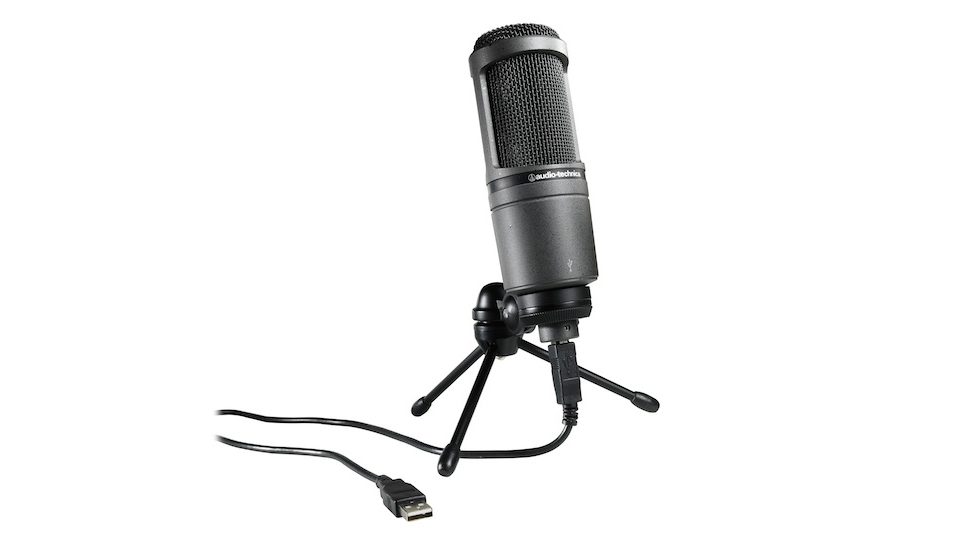If you take a lot of video calls over Skype or Hangouts, record podcasts, make music, or you’re a burgeoning YouTube celebrity, you’ll need a decent microphone for your desktop — one better than whatever’s already built-in. This week we’re looking at five of the best, based on your nominations.
Title photo by Ernest Duffoo
Audio-Technica AT2020

The Audio Technica AT2020 is a popular choice for recording studios, telework-friendly offices and podcasters. It comes in two versions: a USB model (linked above) perfect for connecting directly to your desktop PC, and the original XLR model that’s designed to be connected directly to your mixer or other audio equipment. The USB model is plug-and-play, and works with whatever audio software you already have on your PC. It’s a cardioid condenser mic, so it’s versatile, but it will perform especially well with voice recording. The AT2020 is also a side-address model, meaning it does well when you’re not talking directly into the top.
Samson Meteor

If portability is important to you, the Samson Meteor is one of the smallest USB condenser microphones we’ve seen. It’s tiny, connects to your computer via USB, and serves as both an audio input and an output device, so you can plug your headphones into the mic while you record with it (which is useful for being able to hear yourself while you speak.) It’s a cardioid condenser mic, so again it’s ideal for voice-work such as podcasting, recording and voiceovers. It’s also plug-and-play, and doesn’t require specific drivers to work with any of your devices — even the iPad, if you use it for audio work (specifically Garageband.)
Shure SM-58

If you’re serious about your audio, the Shure SM-58 is a legendary microphone. You’ll find it connected to podcasters’ home computers, professional recording studios, stages everywhere, city halls — virtually anywhere a professional-level microphone is called for, an SM-58 probably isn’t too far behind. It’s not the top of Shure’s product range, but it offers a bang for the buck that just can’t be ignored, even in professional scenarios. The SM-58 is an XLR microphone, meaning you’ll need to connect it to an external mixer, adaptor or a sound card that supports that connection if you want to plug it into your computer. It’s a cardioid dynamic microphone, it’s directional, and you can run it over with a truck.
Blue Yeti/Yeti Pro

The Blue Yeti is an affordable, space-saving USB condenser mic that offers superior audio quality and multiple audio modes so you can use it for different purposes. If you’re doing podcasting or voiceovers, you can set its pickup pattern to cardioid. If you’re recording vocals or singing, set it to stereo. Doing an interview? Set it to bidirectional, or if you’re in a group interview or conference call, set it to omnidirectional. It’s flexible, powerful and easy to use. It’s another plug-and-play USB microphone, and doesn’t need specific drivers to work. It also functions as an audio output as well as an input, meaning you can plug your headphones into it to hear yourself while you record. For more advanced uses, the Yeti Pro features a 24-bit audio interface for better recording, and it sports an XLR connector if you have additional audio gear you need to hook it up to.
Blue Snowball

Another Blue microphone that made the top five is the familiar and widely-used Blue Snowball. Blue likes to say that the Snowball is the world’s first professional USB microphone, and while we agree that it’s been extremely popular among podcasters, at-home audio pros, and generally well loved, that may be a stretch. Still, it’s often used primarily for voice-work, like podcasting and voiceovers, and I’ve seen it used in professional voiceovers as well. It’s a USB condenser microphone that supports both omnidirectional and cardioid pickup patterns, so it can be useful for one person or picking up a room of people. It’s also plug-and-play, meaning no specific drivers are required for its use.
If you’re still on the fence and considering any of the above, or debating using a headset with an attached microphone and want to know what your options are, check out our guide to choosing the best microphone for your computer for more tips.
Want to make the case for your own favourite mic, even if it wasn’t included in the list? Tell us (and tell us why you like it) in the comments.

Comments